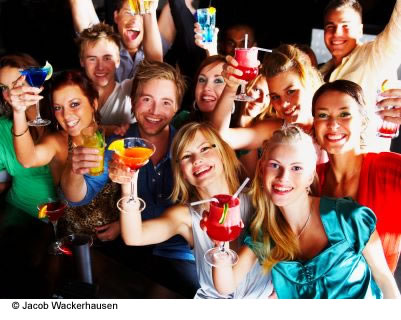 The advertising of alcohol, the marketing of alcoholic products, peer pressure and parental influence all play a part in the level of alcohol consumption among young people.
The advertising of alcohol, the marketing of alcoholic products, peer pressure and parental influence all play a part in the level of alcohol consumption among young people.
These are the findings of a team of University of Leicester experts who have been investigating the effect of alcohol advertising on young people, which also indicate that advertising seems to be most effective in the case of alcopops and cider.
The study was funded by the Alcohol Education and Research Council.
Many teenagers experiment with alcohol. By the time they reach their mid teens, around one in two consume alcohol at least occasionally while increasing numbers drink to the point of drunkenness.
Professor Barrie Gunter, Anders Hansen and Dr Maria Touri, of the University of Leicester Department of Media and Communication, have carried out a study of alcohol advertising and young people’s drinking habits.
Their findings suggest that, while there is mixed evidence as to whether there is a direct link between volume of advertising and volume of alcohol consumption, there are links that can be made between advertising and teenage drinking.
Young people who start drinking alcohol are affected by a range of influences. These include whether their parents drink and pressures from their own peer group. Where social influences conflict, young people will tend to follow the influence most important to them. So, during the teenage years, if parents disapprove of drinking and friends encourage it, the likelihood is that young people will follow the example of their peer groups, not their parents.
Alcohol advertising helps young people become familiar with brands of alcohol, but it is less clear whether it induces them to start drinking in the first place.
On television, as with print journalism, where alcohol is associated with relaxation, fun, humour, friendship and being ‘cool’, it is likely to have some influence, while the use of celebrities, colour, popular music or sexual themes appeared to have a more limited effect.
Retail outlets such as supermarkets and news agents present alcohol promotions in an environment and at a level which will be accessible to young people. However, there was no proof that exposure to such alcohol advertising was as great an influence as the influence of parents and peer groups.
Curiously, young people who go to the cinema most frequently, and are therefore most exposed to the advertising of alcohol on film, were less likely to get drunk, possibly indicating that the type of person who goes to the movies is less likely to drink to excess.
Greater exposure to television advertising, however, did seem to relate directly to the increased chance of getting drunk, particularly in the case of cider and alcopops. There was no significant link between television advertising and most advertised brands of beer, wine or spirits.
Professor Gunter and his research team found that both television and print advertisements generally appeared to be compliant with the 2005 revised advertising codes of practice. Overall, the study found 40 violations, 25 of which occurred in 2003-04 and 15 in 2005-06.
The most common violations linked the advertised alcohol brand with the success of a social event such as a wedding or – more ambiguously – with some activity that could be dangerous if carried out under the influence of alcohol, such as swimming, diving and the use of dangerous machinery.
Source: University of Leicester, via Alpha Galileo
